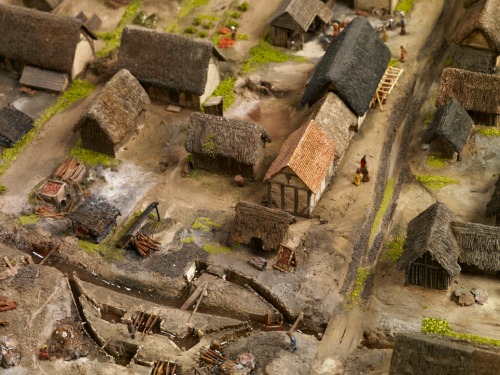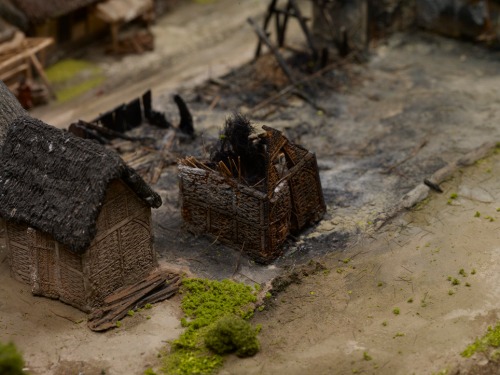Exploring Medieval Birmingham
A scale model allows visitors to depict a scene in a way that words or illustrations sometimes fail to do. To put it simply, it does all the hard work for the viewer by giving them a unique perspective that allows them to survey a landscape in its entirety. We wanted to do exactly that for our visitors. The model we recently commissioned for the new History Galleries illustrates what Birmingham might have looked like in 1300. ‘Might’ is deliberately used here because there are some physical features of the town for which we simply have no concrete evidence. For instance, we don’t know what the fabric of the buildings looked like and whether these buildings were front side or gable end onto the street. Timber framed buildings from the 13th century rarely survive. In Birmingham’s case, its oldest timber framed building is the 15th century Old Crown Pub in Deritend. Nevertheless, we’ve done what historians do best! We’ve used the abundant evidence we have relating to14th century buildings and the limited knowledge from the 13th to produce a ‘most likely’ case scenario.
Model of medieval Birmingham in 1300. Notice the familiar triangular shape to the left of the model, which you can still see today as you walk downhill from New Street to St Martin’s Church.
Some people may be thinking ‘why not just focus on the later medieval period, for which we have more evidence?’ Well, we do have one tangible piece of factual evidence which we’ve based the blueprint of the model on. That is a document called a Borough Rental dating from 1296. This recently discovered document lists the names of townspeople who rented plots of land in Birmingham from the lord of the manor. It also tells us that there were 250 dwellings in Birmingham in 1296. Using this record, along with research from specialists, George Demidowicz and Mike Hodder, we have been able to map rented plots of land that existed in the town. These areas were known as ‘burgage plots’ and in some cases we can pinpoint exactly where certain townspeople lived.
The distinctive long and narrow burgage plots were a common feature of medieval towns. You can also see the ‘half’ plots, where land has been subdivided because of population growth or simply to generate more income.
One such person is Roger le Moul, the wealthiest merchant in 13th century Birmingham. Not only did he own 17 plots, he also gave his name to one of the best known streets in Brum: the Moulestrete of 1437 is today’s Moor Street. Birmingham, a place many assume emerged out of the Industrial Revolution was already thriving in the 13th century and this legacy is embedded in the surviving place and street names of the modern city! Our model, however, doesn’t show the full extent of medieval Birmingham. We’ve simply focused on the market place, the heart of the town, and the burgage plots that surrounded it.
A man who means business! Roger le Moul’s courtyard house, located on what later became Moor Street.
The Borough Rental also helpfully identifies the locations of Birmingham’s early industries, demonstrating why they were situated where they were. Tanning pits, a necessary component of the leather industry were located on Park and Edgbaston Streets. These streets were on the edge of the town and were ideal locations for such a noxious and smelly trade that used urine and animal faeces. Similarly, pottery making, another important early trade was located on the periphery of the town (on the site of Selfridges car park today) because of the fire hazards associated with the craft. In this way, the model really helps to emphasise the rationale of early town planning.
Tanning pits on Park Street, now the site of Selfridges.
Fire was one of the perils of everyday life in any medieval town.
The beauty of our model is that it will help to dispel the myth that there was nothing here in the Middle Ages, when in fact we know that Birmingham was a bustling market centre and home to around 1,500 people. So, if you want to meet William de Birmingham, Richard le Couherde or Isabell le Sonster amongst many other medieval Brummies, visit the new Birmingham History Galleries this October and immerse yourself in the medieval history that made our modern city.
Whether keeping animals, growing food, dying cloth or making pottery, people’s back yards really were places of activity in medieval Brum.
St Martin’s Church sat at the centre of the medieval market town.
The biggest house in town, and home to William de Birmingham, Lord of the Manor.
Look out for my next blog which focuses on the interactive features of the model.
Read Exploring Medieval Birmingham: part II.
Sarah Hayes, Freelance Curator.









Please amend the typo in this release and add a hyphen to make “…15th-century Old Crown Pub in Deritend.” (adjective).
Many thanks, a proud Brummie!
Donato
Oops, another typo!
Please amend to “…to 14th-century buildings…”
Thanks, Donato
Hi Sarah,
A great blog and what an amazing model! The attention to detail is amazing! I look forward to seeing it when you open in October.
As an aside, is that all you gleaned from this blog, Donato? Why not focus on the positives rather than detracting from the blog!? It is a blog and not a broadsheet atticle after all!
Best wishes,
Phil
Really enjoyed this Sarah, love the images too! What alot of research and interesting read 🙂
What a fantastic model. The detail and execution are excellent. We need more of these models used in an intelligent way by museums to bring history to life.
Thanks all! So pleased you’re excited to see the model! On account of the exemplary detail, we’ve created a virtual tour which will be available online in October! Look out for my next blog coming very soon!
I love the model – I am a geographer and studied at Birmingham University – how useful would this model have been during our historical town planning module when our imaginations were stretched thinking of what a ‘burgage plot’ actually looked like?! It’s reassuring to know that not all museums are going down the sole route of computer aided visuals – we need more models like this one.
As an expat ‘Brummie’, I am always interested in anything to do with my home city and the attention to detail in this model is fantastic – leaving in my late teens to go to university, I never considered the layers of history in the Birmingham landscape at that tender age- this model and the accompanying research has opened my eyes! Well done.
My sister also studied geography at B’ham and did that module and made the same comment! Based on what both of you’ve said, I will get in touch with the course tutors and signpost them to the model!
That’s great to hear, GDP, and I know these new galleries will make people even prouder of being Brummies! Before the Bull Ring excavations, most of Brum’s medieval past was below ground and we couldn’t have hoped to have produced a medieval gallery without that archaeology and subsequent research. Keep spreading the word!
What a great model, the detail is amazing. Look forward to taking the virtual tour in October.
Thanks, Mike! Be sure to read part II as well! See link above.
What a lovely comment, thank you! Look out for the virtual tour of the model in October. I know it’ll be a big hit!
I can clearly see the two circles from the original clan settlements in the model. On one, the church sits, it actually looks like it’s resting on a circular stone formation, a former Druidic site?
The second, the house of William De Birmingham. This look likes it rests at the heart of the original settlement in the original clan circle. My impression was that the neolithic early settlements with circular earthen fortified ramparts (sometimes topped with wooden palisades) that were built just inside inside where the moat is now visible, but the model contains no such rampart.
Any specific reason you know of, that the ramparts have been removed ca. 1296?
Here in America, two thousand years ago the native Adena culture built in exactly the same manner. An ancient ruin about 10 Km from where I live still features the circular rampart. It’s about 1m high now, about half the size it was when it was built some 2,200 years ago. We get plenty of rain here with a decent amount of erosion, so the clan circle ramparts in Birmingham must have been excavated at some time before 1296?
Hi there,
Thanks for your interest – it’s nice to know that we’re reaching people in the US.
The impression of the town that you see here is based on a series of archaeological excavations and documentary evidence. Birmingham was part of a planned development in the 12th century, and the town that was created was not built on an existing settlement as far as we know. There’s still much debate about the existence of an Anglo-Saxon village and its likely location.
The circular structure you can see is the moat which we think was constructed around 12th century. The Druidic site you refer to around St Martin’s Church is actually a sandstone ridge, so is a natural formation rather than a man-made structure. This, however, is not to say that Birmingham doesn’t have any prehistoric archaeology – we have a number of handaxes and other tools in our collection at Birmingham Museums. In fact, we will be displaying a Palaeolithic handaxe in the new History Galleries which open on Oct 12th. I hope this helps and answers your questions. If you are interested in learning more about Birmingham’s prehistory, a great book to read is Birmingham, the Hidden History by Michael Hodder. It’s a fantastic resource.
Best wishes,
Sarah
What a wonderful model and a powerful tool for learning and engagement. Forget CGI, just looking at these photos and reading the stories make the whole exhibit (and the history) come to life. Looking forward to seeing it in the flesh.
Susie, I hope you’ve had time to visit! If not, check out this link to the ‘virtual tour’ of the model: http://www.youtube.com/watch?v=JZq9cBzrIVI